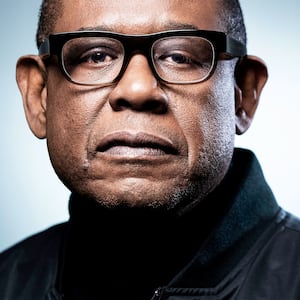Following the critical success of Moonlight, it’s hard to believe that any Barry Jenkins project would be met with trepidation by the public. But in the almost five years leading up to the Oscar-winning filmmaker’s television adaptation of Colson Whitehead’s Pulitzer Prize-winning novel The Underground Railroad, the announcement that yet another story set during slavery and inevitably portraying Black pain and trauma would soon be put out into the world prompted some negative sentiments online.
Conversely, social media users familiar with Jenkins’ filmography met the news of the limited series and its trailer mostly with excitement. But even the director and screenwriter, who’s known for his tender, nuanced portraits of Black life, reconsidered his involvement with the series at one point, according to a recent profile by The New York Times, noting the complications of depicting racial violence when these images—fictional and real—are nearly inescapable and offer little service to the Black people forced to encounter them.
But if any A-list director working today knows how to strike an ideal balance of the beautiful and the grotesque, honest, unflinching brutality countered by flickers of hope and underlying resilience, it’s Jenkins.
It’s hard to choose just one singular moment that exemplifies the 41-year-old auteur’s proficiency in this tricky area throughout the 10-part series, which premieres on Amazon Prime today. Jenkins’ curatorial judgment in transporting the toughest and most grisly parts of Whitehead’s novel to screen while highlighting the however short-lived joy of attaining a semblance of freedom feels like a course correction for the past decade of prestige films and television shows, such as 12 Years A Slave, A Birth of A Nation, Antebellum and Prime’s other new series Them, concerned with harnessing the white gaze as a means of subversion. In removing that gaze entirely, The Underground Railroad illustrates the kind of storytelling that’s possible when artists revel in the humanity of their Black subjects as opposed to their suffering.
The fantasy epic begins in an unspecified time in antebellum Georgia where an enslaved man named Cesar (Aaron Pierre) is trying to convince the story’s main protagonist Cora (Thuso Mbedu) to flee their plantation. Cesar considers Cora good luck because of her mother Mabel’s (Sheila Atim) successful escape when she was child. While oppositely, Cora has always internalized her mother’s accomplishment as a selfish, hurtful act. In addition to the torment she experiences at the hands of her sadistic owners and other slaves in higher social standing than her, her mother’s abandonment has left a festering wound that’s diminished her sense of personhood.
But when the relentless brutality of plantation life becomes too much to bear, she decides to embody her mother’s heroicness and take advantage of Cesar’s knowledge of an elusive, mystical underground railroad. In contrast to the actual passage of enslaved people on foot, Whitehead’s rendering of the transporting system is a literal locomotive that operates on a sparse, unreliable schedule in abandoned caves and more modern subways and with little information about its comings and goings as well as its conception.
When the companions blindly arrive at their first destination, an outwardly pleasant South Carolina town dedicated to the “betterment” of the Negro population, they eventually find themselves on the receiving end of eugenics-driven experimentation. A more urgent threat, however, is a slave catcher named Ridgeway, played by the series’ most famous actor Joel Edgerton, hired to return Cora and Cesar to their plantation where they’ll inevitably receive the most tortuous of punishments and probably death.
What follows throughout the rest of The Underground Railroad is an occasionally slow-moving but harrowing chase through different parts of the country. Cora is offered various interpretations—illusions rather—of freedom throughout her journey that include the aforementioned paternalistic “safe haven,” an abolitionist’s claustrophobic attic in North Carolina and a Black-run Indiana farm that’s more concerned with obliging to the comfort of their white neighbors then the safety of its fugitive population—all representative of a question constantly being asked in the age of camera phones and social media: Where is it safe to Black? We also see Cora and her enslaved peers negotiate the meaning of death as a way to liberate oneself from the hands of white men in their final moments on Earth.
At times, Cora, played by Mbedu with a near-constant wide-eyed panic that doesn’t always relay the variety of emotions she encompasses in the book, can feel more like a cog in the series’ overall thesis as opposed to someone Jenkins and the rest of the series’ writers are interested in unraveling. Cora certainly never feels blank or one-dimensional. But her trauma regarding her mother is often acknowledged in a way that feels obligatory and solely symbolic as opposed to the way Ridgeway’s fractured relationship with his father is surgically constructed and weaved into his storyline.
In that same vein, some viewers might see the introspection of Ridgeway’s character, including a bottle episode dedicated to his backstory, a little off-putting considering the history of white characters being centered in on-screen portrayals of Black oppression. But his character upends an exhausting trope in historic movies and television shows in which racist, white people are boringly portrayed as cartoonish, mustache-twirling villains. Edgerton also earns his screen time, with what might be the best performance of his career thus far.

Standout performances also include Chase W. Dillon as Homer, Ridgeway’s precocious, young sidekick. Out of all the supporting characters that are given depth throughout the series, Dillon’s Homer manages to be the most captivating presence. It’s not just his conditioned and involuntary role as a slavecatcher’s assistant or his stately manner amidst the rest of his struggling Black peers that piques our interest every time he enters the camera frame, but Dillon’s ability to emote all the complexities of his predicament with just a few lines of dialogue per episode. William Jackson Harper, of The Good Place fame, as Royal, one of Cora’s rescuers from Ridgeway, is as charming and acute as usual. Even brief appearances by side characters like Ellis, a new train conductor, played by Marcus “MJ” Gladney, and Lovey, an enslaved girl on Cora’s and Cesar’s plantation, played by Zsane Jhe, are as impactful as longer-written characters.
I’d also be remiss not to mention Nicholas Britell’s gorgeous, strings-accompanied score, merged with sounds of wildlife and the whistle of a train, that smoothly oscillates between soothing, melancholic, and menacing.
Underground Railroad is not a perfect adaptation despite how meticulously crafted it is in certain areas. Jenkins’ characteristically still, meditative lens on his characters is occasionally at odds with the fast, urgent pace of the novel that makes it such a compelling read. Additionally, the gorgeous, refined aesthetic that Jenkins and his cinematographer James Laxton have made a hallmark of their work feels less exact in certain locations, like the North Carolina town and the Tennessee woods set ablaze. Regardless of its imperfections, Jenkins’ vision is still executed in a thoughtful, incisive way that will hopefully serve as a blueprint for more shows and films like it in the future.


